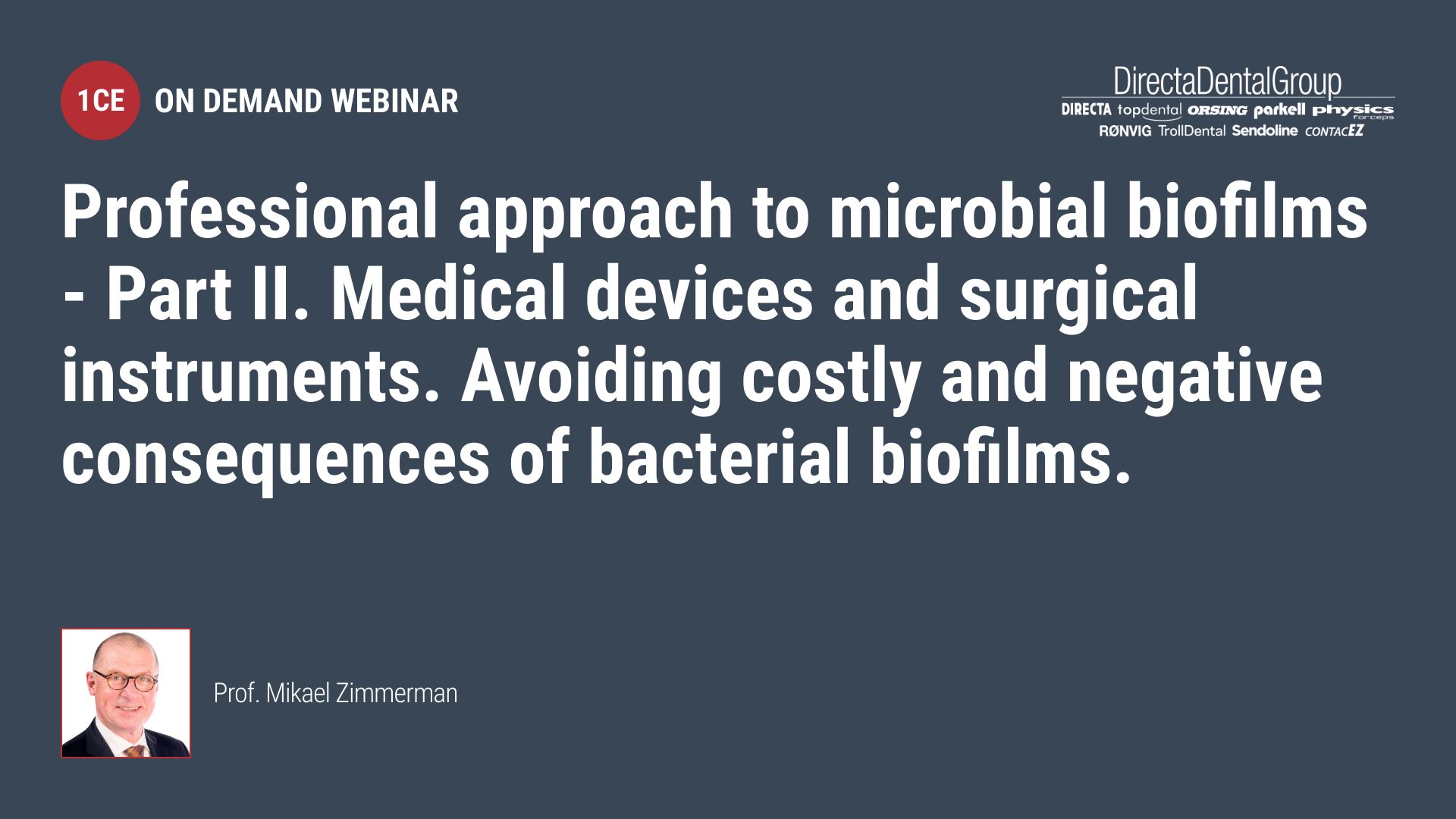PLEASE LOGIN OR REGISTER
In order to register for a webinar you must be a member of our website. If you already have an account, please login.
Register Now Login

In order to register for a webinar you must be a member of our website. If you already have an account, please login.
Register Now Login
This is the second part of a series comprising two separate webinars of interest for the whole dental team. It covers the clinical importance of microbial biofilms as well as maintenance and reprocessing of instruments.
Objectives
The webinar is designed to update the whole dental team about bacterial biofilms and:
Both wet and dry biofilms associated with medical devices are well known to be linked to healthcare associated infections. Metabolites and bioactive bacterial substances released from both wet and dry biofilm can have deteriorative effects on patient health and treatment outcome.
Bacterial stress such as desiccation and exposure to chemicals can enhance the production of extracellular substances which can further strengthen the biofilm protection.
Bacterial biofilms can affect and destroy medical biomaterials, where bacterial corrosion of metal is an important consequence. In the biofilm society bacteria will coordinate metabolic activities which over time creates a more functional bacterial corrosion cell – not only affecting metals but all types of medical devices.
Quality and design of medical devices and instruments are important factors to increase resistance against negative effects from bacterial biofilm activities.
The characteristics and composition of different surfaces, environmental as well as dental/medical materials, can inhibit the establishment of biofilms.
Proper reprocessing of medical devices is highly cost-effective. The efficacy of cleaning, disinfection and sterilizing processes are dependent upon the type of equipment, consumables, microbiocidal activity, choice of cleaning and disinfection agents, allotted time and motivation of staff.
Release date: 2022-10-26 | Expiration date: 2025-10-26
If you have questions regarding this webinar, please contact us.
18 Comments
Thank you prof
Sorry for asking so many questions.Maybe I can ask you more via email
Dr Joseph Kamal Muhammad
Email: jkmomfs@hotmail.com
Is there a difference between aqueous chlorohexidine and alcohol based chlorohexidine?
Piezosurgery surgery is said to decontaminate a surgical field by the cavitation effect. Can you kindly elaborate?
is there a minimal time laps for the chemical agents to be effective? excessive time soaking harms the instruments?
Do we need to take any additional precautions for patients with reduce immunity such as diabetes? I am thinking of antibiotic cover for oral surgical procedures
I there any possibility of synergy of using hydrogen peroxide and hypochlorite solution together?
Thank you
Does ultrasonic cleaning have a role to play in removing organic material from instruments?
In your presentation you did not mention hydrogen peroxide as an agent to use against the biofilm, Could you kindly elaborate?
on the foto you show us reks for the thermodesinfector, where can we buy these?
May I ask if an oral rinse with aqueous chlorhexidine solution prior to an oral surgery will assist decontamination of the surgical field?
May I ask about the effect of tobacco smoking on the oral microbiome?
Could you kindly share your opinion on the use of tungsten carbide to coat the surface of surgical instruments? Should such instruments be handled differently to conventional steel instruments?
Sometimes a wire brush is used to clean surgical instruments. May I ask if such brushes could damage the surface of the instrument and predispose it to biofilm deposition?
Wonderful presentation. The instrument companies use different types of steels. For example German and Japanese steel. May I ask if particular types of steel are more or less susceptible to pit corrosion?
is HCLO (hypocholrous acid) as effective as Naclo at removing biofilm? I believe it it much safer to use if worried about pushing nacl0 through the apex during rct and causing bone necrosis etc
Thank you for sharing your knowledge and experience. May I ask about the susceptibility of different types of dental implant surfaces to biofilm establishment and how can implant surfaces contaminated by biofilm can be treated
Thank you for joining today’s webinar! If you have any questions for Prof. Mikael Zimmerman please write them in this chat box and they will be addressed at the end of the presentation.